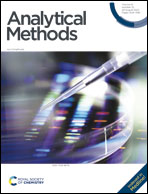Quality grade evaluation and related antioxidant activity research of different medicinal parts of Catalpa fruit†
Abstract
Catalpa fruit is a traditional Chinese medicine used in the treatment of diuresis and detumescence; however one-sided quantitative or qualitative investigation limits its overall quality evaluation. Hence, this study proposed to qualitatively and quantitatively evaluate the quality consistency of Catalpa fruit from the perspectives of chromatography and spectroscopy. First, the fusion fingerprints of 15 batches of Catalpa fruit pericarp and 15 batches of Catalpa fruit seed were established by high performance liquid chromatography (HPLC) and ultraviolet (UV) spectroscopy in equal weights, respectively, to avoid the unilaterality of a single analytical technique. The different medicinal parts of Catalpa fruit were graded and evaluated based on a systematically quantified fingerprint method, and the quality of the pericarp and seed was further investigated. The results revealed that the quality of most pericarp and seed samples was within the acceptable level range (grade ≤ 5), and that seed quality was clearly superior to pericarp quality. Furthermore, according to the research findings, the content of p-hydroxybenzoic acid in Catalpa fruit pericarp was generally higher than that in Catalpa fruit seed, while the content of catalposide was generally lower than that in Catalpa fruit seed. Additionally, the fingerprint–efficacy relationship with HPLC was discussed by binary correlation analysis, which indicated that catalposide had the strongest antioxidant activity. This study demonstrated that the analytical techniques based on chromatographic fingerprinting, spectral fingerprinting and antioxidant activity provided new theoretical foundation as well as technical guidance for Catalpa fruit quality control and rational utilization.



 Please wait while we load your content...
Please wait while we load your content...